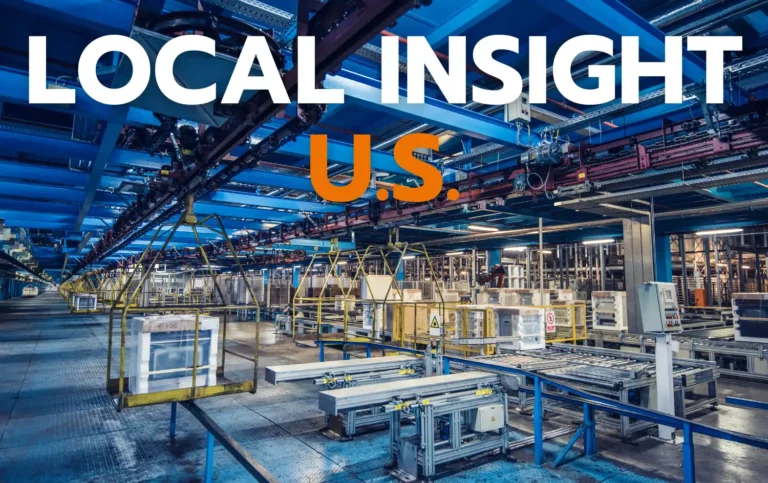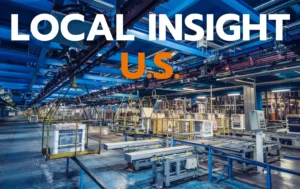The numbers tell the story. General Motors announced a 4 billion investment in electric vehicles manufacturing. GE Aerospace committed 4 billion across three U.S. manufacturing facilities. Manufacturing construction spending has doubled since 2021, reaching $189.7 billion in 2024, principally driven by construction for computer, electronic, and electrical manufacturing which has nearly quadrupled since 2022.
Foreign direct investment in U.S. manufacturing totaled $67.7 billion in 2024, representing 44.9% of all new FDI. While headlines focus on 4 billion investment announcements from giants like GM and GE Aerospace, the real opportunity belongs to mid-cap manufacturers positioned to move faster and capture supply chain gaps these mega-investments create.
2025 represents a convergence point where policy incentives, supply chain realities, and competitive pressures create unprecedented opportunity for international mid-cap companies ready to invest in America.
The American Manufacturing Renaissance: Factory Investment Beyond the Headlines
The American manufacturing revival is powered by mid-cap companies in the sweet spot between agility and scale. Mid-cap manufacturers generate $500M-$5B in annual revenue, with 53% generating $3B-$5B annually and average revenue of $3.0 billion.
This shift toward domestic manufacturing is powered by strategic necessity. 22% of U.S. manufacturers have shifted operations back home since 2022, creating supply chain opportunities that mid-cap companies are positioned to capture through investment in U.S. operations.
The Inflation Reduction Act and CHIPS and Science Act have created policy frameworks designed to boost American innovation through investment in manufacturing. The CHIPS Act provides 25% investment tax credits for qualified advanced manufacturing facilities, making new investment in U.S. manufacturing facilities attractive for mid-cap companies.
$220 billion in domestic manufacturing capacity has been pledged through 2026, creating new manufacturing jobs and strengthening U.S. supply chain resilience across aerospace, semiconductor, and electric vehicles sectors.
Strategic Manufacturing Investment Opportunities: Where 4 Billion Dollar Factory Decisions Signal Mid-Cap Success
Aerospace Manufacturing Investment: GE Aerospace Leading Advanced Manufacturing
GE Aerospace’s 4 billion investment across three U.S. manufacturing sites reflects the aerospace sector’s strategic importance. Aerospace manufacturing combines high-value production with national security priorities, creating new investment opportunities for mid-cap companies with relevant capabilities.
The aerospace supply chain increasingly prioritizes U.S.-based production for critical components, driving investment in manufacturing that supports American jobs while strengthening domestic manufacturing capacity. Mid-cap companies specializing in precision controls and aerospace components are positioned to benefit from aerospace supply chain reshoring through strategic investment in U.S. manufacturing operations.
Industrial Manufacturing Plant Leaders: Mid-Cap Investment Opportunities
Mid-cap manufacturing companies represent the optimal balance of scale and agility for manufacturing investment:
Powell Industries (POWL) – $800M revenue, $2.5B market cap electrical infrastructure specialist focusing on AI data center power infrastructure, positioned to serve the data center boom supporting AI and advanced manufacturing.
Simpson Manufacturing (SSD) – $2.1B revenue, $2.2B market cap factory construction materials provider directly benefiting from manufacturing construction growth through fasteners and structural components essential for building new manufacturing facilities.
SPX Technologies (SPXC) – $1.4B revenue, $4.8B market cap industrial automation equipment manufacturer serving factory automation needs with focus on manufacturing and research and development.
Modine Manufacturing (MOD) – $2.3B revenue, $7.1B market cap thermal management leader providing electric vehicles thermal systems and data center cooling solutions for electric vehicle production lines.
Semiconductor Manufacturing: New Investment in US Manufacturing Excellence
Mid-cap semiconductor companies are eligible for CHIPS and Science Act benefits, including 25% tax credits for advanced manufacturing facilities. The semiconductor manufacturing sector requires scaling production of innovative parts made from new materials and advanced manufacturing processes that support domestic manufacturing.
Semiconductor manufacturing drives investment in manufacturing facilities across the U.S., with companies planning significant investment in manufacturing capacity. Mid-cap companies serve as critical suppliers to mega-investments, providing specialized components and manufacturing equipment.
Electric Vehicles and Advanced Manufacturing: The Supply Chain Investment Revolution
The automotive transformation represents the largest manufacturing investment wave since World War II, with electric vehicles requiring fundamentally different manufacturing capabilities: battery production, electric motor manufacturing, power electronics, and advanced materials processing.
General Motors’ ongoing commitment to build vehicles in the U.S. includes a 5 billion investment in electric vehicle production across multiple manufacturing sites. Ford has announced plans to invest 3.5 billion in Michigan manufacturing operations. The auto industry drives significant investment in U.S. manufacturing capacity.
Mid-cap suppliers with expertise in battery technology, electric powertrains, or lightweight materials can establish new U.S. manufacturing operations to serve multiple OEMs while accessing federal clean energy incentives. The opportunity extends to scaling production of innovative parts made from new materials and advanced manufacturing processes.
Regional Investment Advantages: Where to Deploy Manufacturing Investment Capital
Texas: Manufacturing Investment Leadership
Texas leads U.S. manufacturing investment with $22.8 billion in new FDI in 2024. The state offers structural advantages: business-friendly policies, energy resources, transportation infrastructure, and workforce capabilities that support new manufacturing jobs.
For mid-cap manufacturers, Texas provides immediate access to Mexico through USMCA trade benefits, energy cost advantages, and state-level incentives that complement federal programs. Texas manufacturing sites enable companies to serve both domestic and export markets efficiently.
Georgia: Southeast Manufacturing Hub
Georgia attracted $16.3 billion in manufacturing investment in 2024, driven by electric vehicles and battery production. The Southeast’s transformation from textile manufacturing to advanced manufacturing represents successful regional economic transition.
Georgia, South Carolina, Tennessee, and Alabama offer competitive labor costs, infrastructure, and incentive packages. Mid-cap companies can establish manufacturing operations to serve the automotive ecosystem while accessing regional supplier networks.
California: High-Tech Manufacturing Innovation
California’s manufacturing investment reflects the state’s position in high-tech manufacturing. California offers access to innovation, talent, and capital markets for mid-cap companies in biotechnology, aerospace, or advanced semiconductor applications ready to invest in America.
Government Investment Programs: Manufacturing Renaissance Support
CHIPS Act Implementation for Domestic Manufacturing
The $52.7 billion total allocation for semiconductor manufacturing and research includes provisions for mid-cap companies planning investment in manufacturing facilities. The 25% investment tax credit for qualified advanced manufacturing facilities applies to manufacturing plant investments, making federal incentives accessible to mid-cap manufacturers.
The CHIPS and Science Act specifically supports investment in manufacturing that strengthens U.S. supply chain resilience and creates manufacturing jobs through investment in semiconductor manufacturing and related manufacturing operations.
Manufacturing Construction Investment Incentives
The manufacturing construction boom creates supply chain opportunities for mid-cap companies in:
- Materials suppliers serving new manufacturing facilities
- Equipment manufacturers supplying factory automation systems
- Process technology providers supporting advanced manufacturing processes
- Construction services for manufacturing plant development
M&A and New Investment Opportunities
Manufacturing M&A reached $92 billion across 340 deals in 2024, up 15%. 70% of mid-sized manufacturers ($50M-$500M) are family-owned, creating acquisition opportunities for mid-cap companies looking to expand manufacturing capacity.
Mid-cap companies trade at 6-8x EBITDA versus 10-12x for technology-enhanced industrials, providing favorable acquisition opportunities for companies ready to invest in America.
Strategic Manufacturing Investment Execution: The Mid-Cap Framework
Success in U.S. manufacturing investment requires understanding that factory location decisions shape competitive positioning for decades. Mid-cap companies have unique advantages: sufficient scale to access federal incentives while maintaining agility to move quickly when opportunities arise to invest in America.
Phase 1: Strategic Investment Assessment and Supply Chain Intelligence
Mid-cap companies must analyze multiple potential regions using comprehensive evaluation beyond cost comparisons for manufacturing plant development:
Supply Chain Integration: Mid-cap companies serve as critical suppliers to mega-investments, requiring proximity to major manufacturing hubs and transportation networks that support investment in manufacturing operations.
Workforce Development: Manufacturing jobs increasingly require advanced skills: robotics operation, data analysis, quality control systems, and process optimization that support American jobs.
Investment Optimization: Automation investments of $50M+ can cut labor costs by 15-20%, making technology adoption critical for mid-cap competitiveness in advanced manufacturing.
Phase 2: Regulatory Navigation and Investment Optimization
Mid-cap manufacturers must coordinate facility investment, regulatory compliance, and incentive capture for successful manufacturing investment. The EPA Small Business Compliance Policy provides incentives for environmental compliance in new manufacturing facilities.
Companies planning manufacturing operations must navigate U.S. supply chain requirements, domestic manufacturing content standards, and potential tariff implications while optimizing investment in manufacturing that qualifies for federal incentives.
Phase 3: Operational Excellence and US Manufacturing Market Entry
Manufacturing success requires ongoing optimization of operations, talent acquisition, and market positioning for companies investing in U.S. manufacturing capacity. Mid-cap companies that view factory opening as the beginning build sustainable competitive advantages through operational excellence and continued investment in manufacturing and research and development.
Investment Timing: Why 2025 Manufacturing Renaissance Demands Action
The current investment environment combines maximum incentive availability with minimum competition for resources. Federal programs are at peak funding levels, state incentives remain generous, and workforce development programs are expanding rapidly to support new manufacturing jobs.
This window is time-limited. As manufacturing sites fill and labor markets tighten, incentive packages will become less generous. Mid-cap companies that establish new U.S. manufacturing operations now secure choice locations and maximum government support while positioning themselves to support American jobs through investment in manufacturing facilities.
The Manufacturing Investment Multiplier Effect
Manufacturing investment creates multiplier effects beyond individual manufacturing facilities. Every significant investment in manufacturing creates additional economic activity through supplier networks, service providers, and community development that supports American jobs and private investment growth.
For mid-cap investors, this multiplier effect translates to market access opportunities. A manufacturing plant becomes a platform for market penetration, customer development, and innovation collaboration. Mid-cap companies that view U.S. manufacturing investment as market entry rather than just production gain strategic advantages while contributing to investment to boost American innovation.
The ALTIOS Advantage: Mid-Cap Manufacturing Investment Expertise
At ALTIOS, we’ve guided over 12000 international projects through market entry decisions across 30+ years. Our experience with mid-cap manufacturing investment reveals that success requires executing sophisticated strategies tailored to each company’s industrial logic and competitive positioning.
Our approach combines market intelligence, regulatory expertise, and cultural integration capabilities that most mid-cap companies lack internally for complex manufacturing investment projects. We coordinate the complete implementation process, from initial site assessment through operational excellence for mid-cap companies ready to invest in America.
The Next Manufacturing Wave: Mid-Cap Leadership
The current manufacturing renaissance represents the early phase of a longer transformation. Mid-cap companies that act decisively in 2025 will benefit from this transformation while building manufacturing capacity for domestic manufacturing and export growth.
The opportunity is clear. The timing is optimal. The question isn’t whether to invest in America—it’s how to execute with the strategic sophistication that positions mid-cap manufacturers for long-term success.
ALTIOS helps international mid-cap manufacturers navigate the complete spectrum of U.S. market entry—from strategic assessment through operational excellence. Contact us to discuss how our proven methodology can accelerate our American manufacturing strategy and capitalize on the opportunities defining the manufacturing renaissance.








